Savage 308 Can It Be Converted to Mag Feed
Full Review: Savage 110 Ultralite Rifle with Carbon-Fiber-Wrapped Barrel
Savage ups its game with the new 110 Ultralite, this high-tech bolt-action rifle shows the direction the legendary company is headed.
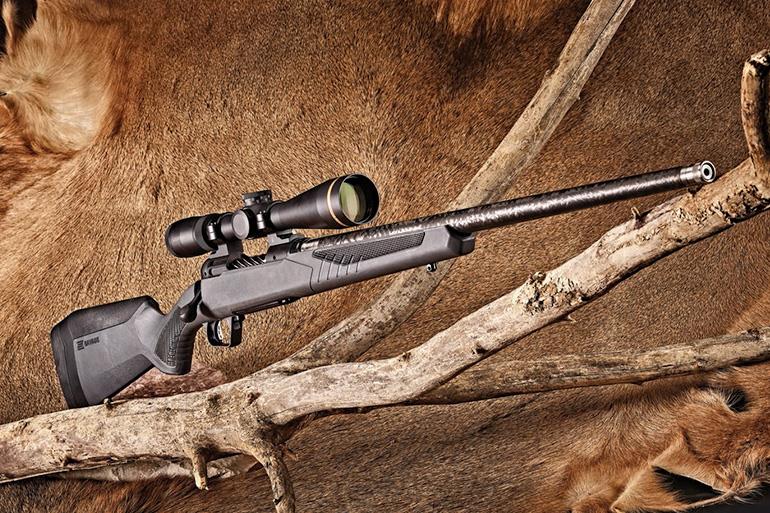
(RifleShooter Magazine photo)
March 12, 2021
Savage Arms is under new ownership, and as with any changing of the guard at a major firearm manufacturer, there's a period of uncertainty when the shooting public waits to see in which direction the new bosses take the brand. With the launch of the new 110 Ultralite carbon-fiber barrel hunting rifle, it's clear Savage's new leadership is planning to take this company to the top—to the top of the market, but also to the top of a ridge where a bull elk is bugling and to the top of a shale slide with a 40-inch ram on the other side.
That's because the newest addition to the 110 line is also the lightest 110 available, the sub-six pound Ultralite. As the name implies, this new rifle uses the same time-tested Savage action that has made the 110 a favorite of hunters for years. The push-feed design features a floating bolt head, which ensures both lugs make full contact with the lug abutments, and a barrel nut for proper headspacing. Savage led the movement toward better triggers in factory rifles with the release of the AccuTrigger in 2002, and of course it is installed in the Ultralite.
The 110 Ultralite is a modern take on the lightweight hunting rifle. The stainless steel receiver has been trimmed down nearly everywhere to cut weight and given a protective Melonite nitrocarburized finish that protects the metal against the elements. The blueprinted action features a bolt with spiral fluting with a contrasting natural stainless and Melonite finish.
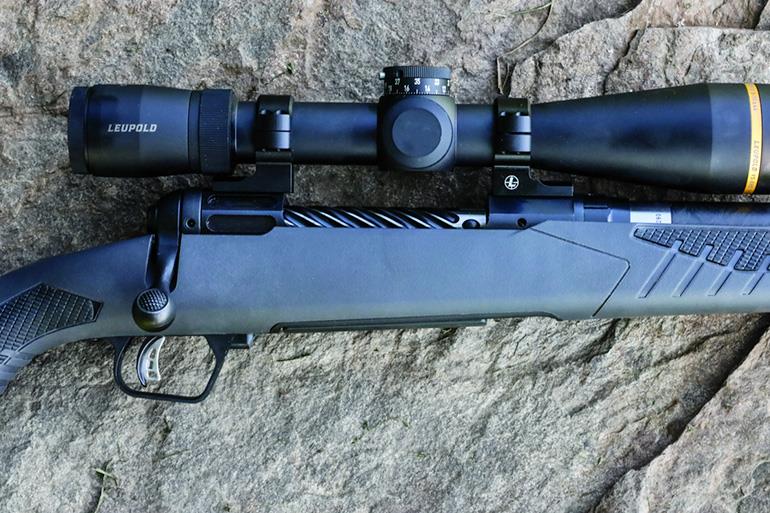
The heart of the rifle is the 110 action, which features Savage's AccuTrigger. For the Ultralite, the action is blueprinted and shaved of as much weight as possible. (RifleShooter Magazine photo)
The Proof Research barrel is carbon-fiber-wrapped stainless steel and includes cut rifling and a 5/8x24 threaded muzzle with cap. Proof Research carbon-fiber barrels have become extremely popular in recent years, with a reputation for delivering superb accuracy with minimal weight. Also, carbon-fiber barrels dissipate heat quickly and efficiently.
The barreled action is mated to a gray polymer stock equipped with Savage's AccuFit system, which provides a fast and easy way to adjust the rifle for a proper fit. The AccuFit system allows shooters to quickly and efficiently adjust the rifle's comb and length of pull by swapping out modular stock inserts, and in the spirit of lighter-is-better, the swappable inserts weigh less than having an adjustable stock and all the requisite hardware that goes along with it. What's more, the soft-touch comb surface won't batter the shooter's face under recoil.
Speaking of soft-touch surfaces, 110 Ultralite stocks come with soft-touch black polymer inserts on the sides of the fore-end and pistol grip. The surface provides a secure and comfortable hold on the rifle, and the stock angles are well suited for maximum shooting comfort from most shooting positions. Angular cuts and lines on the stock are designed to give it a modern look.
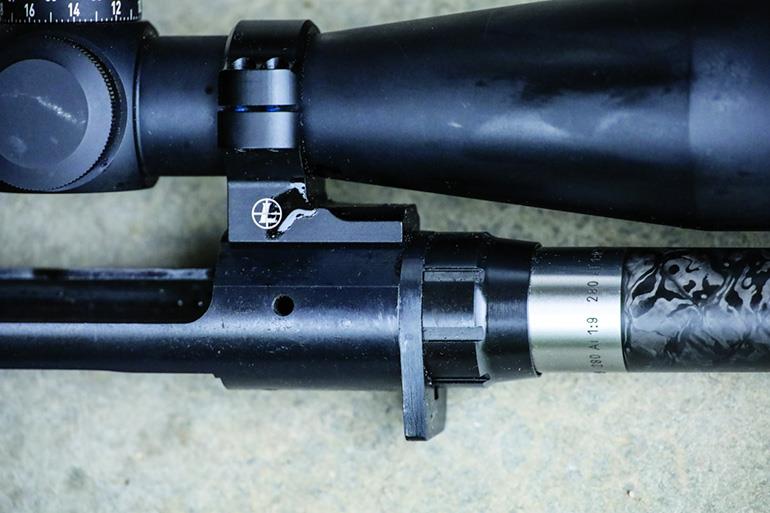
The Savage 110 Ultralite action is mated to a 22-inch, carbon-fiber-wrapped Proof Research barrel, an accurate setup that weighs just under six pounds. (RifleShooter Magazine photo)
The AccuTrigger remains one of the safest and lightest triggers on the market. The bladed design requires the trigger to be pulled before the gun can be fired, and this trigger is easy to adjust for shooters who aren't mechanically inclined. The current generation of AccuTriggers is adjustable from 1.5 to 4 pounds, and the trigger on the test rifle broke at exactly two pounds when tested on an RCBS gauge.
Thanks to the 110 Ultralite's machined action, which eliminates about every piece of steel that wasn't required for structural strength, and the carbon-fiber Proof Research barrel, these guns weigh six pounds or less. The test gun, which came chambered in .280 Ackley Improved, weighed just 5.85 pounds without a scope. Proof Research barrels are up to 64 percent lighter than comparable steel barrels, so even with the heavy-barrel profile that tapers from just over an inch wide down to about 0.75 inch at the muzzle the gun still doesn't weigh as much as competing sporters. The use of polymer parts wherever applicable also saves weight.
Savage 110 controls are minimal. There's a tang-mounted, three-position sliding safety that's well positioned and easy to engage. The magazine release is located on the front of the magazine box, and the bolt release button is located in front of the trigger guard.
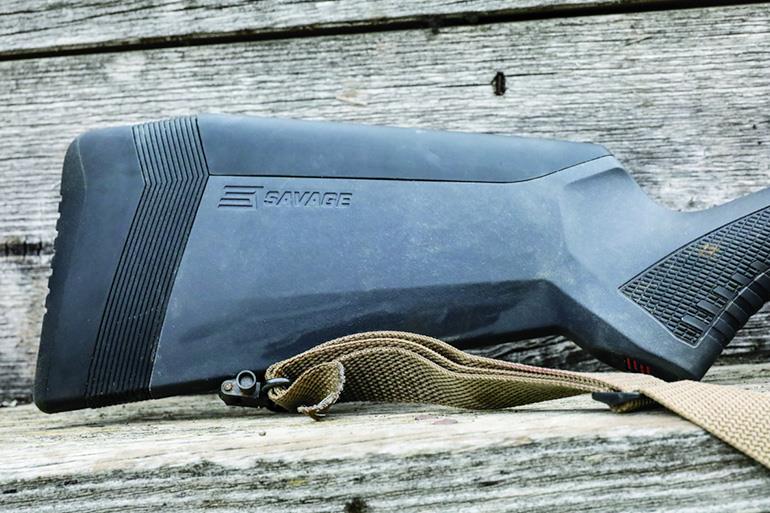
The Savage AccuFit stock comes with length-of-pull spacers and comb inserts in different sizes to quickly and easily customize the fit. The soft-touch comb surface helps reduce recoil impact to the face. (RifleShooter Magazine photo)
Recommended
Advertisement
The 110 Ultralite is available in 6.5 Creedmoor, 6.5 PRC, .270 Win, .280 Ackley Improved, .28 Nosler, .308 Win, .30-06 and .300 WSM. Regardless of caliber, suggested retail price is $1,499, which is a pretty outstanding considering a Proof Research barrel alone costs two-thirds of that.
Still, $1,500 is more money than most hunters are accustomed to paying for a Savage rifle, so if the 110 Ultralite is going to compete with rifles in this price range, which includes premium guns from Browning, Kimber, Christensen Arms and others, it has to perform. And the 110 Ultralite is an accurate rifle indeed. The best three-shot group came courtesy of Hornady's .280 AI Precision Hunter load pushing a 162-grain ELD-X bullet at around 2,800 fps and measured exactly 0.40 inch center-to-center—clearly outstanding for a factory rifle/ammunition combination.
All three groups using that load went significantly under an inch with the average being 0.59 inch, which is great by any standard. Federal's new Terminal Ascent hunting ammo produced a group that measured 0.64 inch and averaged under an inch, too. The last load, a handload with Hornady's 150-grain GMX bullet at 2,750 fps, averaged right at an inch for three shots.
Three loads and three groups at an inch or better. That's the type of stuff you want to see from a new rifle, and it proves once again that Savage can produce factory guns able to compete with brands typically costing more.
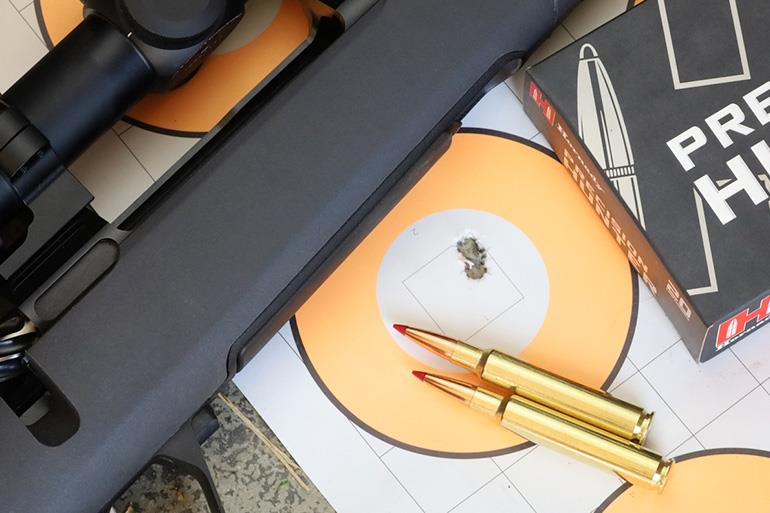
The 110 Ultralite proved incredibly accurate. This three-shot group at 100 yards came using Hornady's 162-grain ELD-X Precision Hunter load. The average group size for that load was just a bit over a half-inch. (RifleShooter Magazine photo)
Savage rifles come with a long list of shooter-friendly features. I'm a big fan of the tang-mounted safety because it's easy to access from any shooting position, including prone. Also, disengaging the safety can be done silently and doesn't require a lot of game-scaring movement, which is a useful feature.
The AccuTrigger works well, and the test rifle's two-pound break was clean and predictable. Having the ability to adjust the length of pull and comb height courtesy of the AccuFit stock is also a nice touch. Last but not least, I appreciate that this rifle is built to withstand the worst elements.
However, I wasn't particularly fond of the included box magazines, which aren't exactly easy to load and require a concentrated effort to secure in the rifle. They function well for the most part, but I did have a few issues where the top round wouldn't chamber. The injection-molded stock works fine, but the geometric lines and cuts don't do much for me. I guess I prefer modernity in small doses.
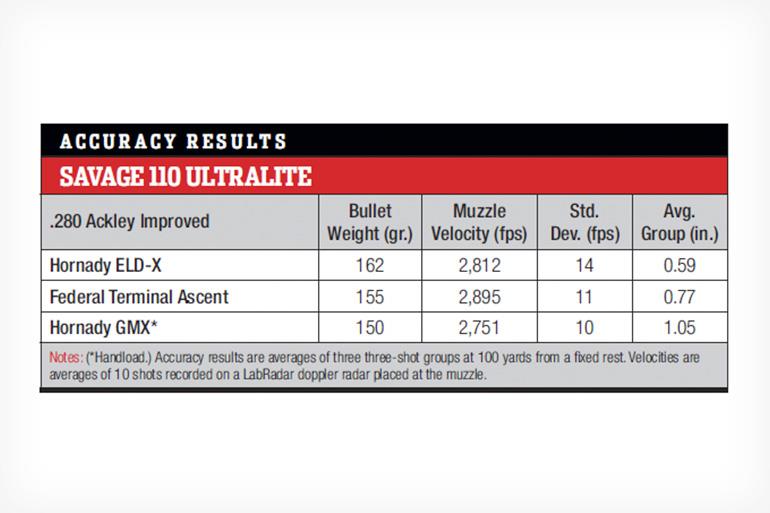
(RifleShooter Magazine chart)
A fancier stock and improved magazines would quickly drive up the cost of the 110 Ultralite. Those upgrades would turn the $1,500 rifle into a $1,750 rifle in a hurry, and that would put the Ultralite out of reach of some shooters. I don't mind wrangling with the magazine, and stock design isn't a major factor as long as stock architecture is good, which it is on this gun.
For what you're paying, you get a solid, dependable rifle incorporating a carbon-fiber barrel for a price that is half—yes, half—of some competing guns. If you want a capable carbon-fiber rifle but don't want to spend $2K or more, this is your option, and it's a solid one.
Most rifle tests end when the last targets are removed from the range. In this case, I had a chance to conduct a more in-depth performance review of the 110 Ultralite, and that would carry me 5,000 miles north from my home.
I was part of a group of writers scheduled to hunt caribou on the Arctic Slope of Alaska, a trip Savage arranged as to test the merits of the 110 Ultralite. Our base camp was a collection of tents scattered across a rocky island in the center of the river. From there, we fanned out in rafts or on foot up the surrounding watercourses in search of the Western Arctic caribou herd. It was the perfect venue to test the durability and accuracy of a brand-new big game rifle.
The 110 Ultralite didn't have an easy row to hoe, either. Rain battered us every day, and between being dragged through dense willows and ferried in the bottom of a rubber boat, the Ultralite took a serious beating. If you've ever hunted Alaska, you know that being dry is a rare luxury, and that didn't happen throughout the duration of our trip. The 110 Ultralite was drenched for a week straight, but it held up.
I spotted my caribou more than a mile away. That's not terribly far for a tundra hunt, and the terrain wasn't particularly steep, but the whole countryside was one mass of muskeg. For those unfamiliar with the stuff, muskeg is round, elevated clumps of weeds surrounded by moats of mud. The grass hides the surface of the ground so that you're forever guessing where to step and you always make the wrong choice. Going after that bull was going to be a challenge.
After a long and circuitous hike, we eventually caught up to the bull. He'd moved to our left and was skylined on a ridge just above us, 300 yards away. I dialed the Leupold VX-5HD optic up to full magnification and adjusted the CDS dial to the proper range. My 19-year-old guide, Geordy Pine, who proved to be wise beyond his years, urged me to shoot quickly if I could because the bull was about to disappear over the top.
I needed no prompting because I had no desire to navigate through another field of ankle-breaking muskeg. When the 110 Ultralite came steady on my pack, I pressed the safety forward and squeezed the trigger. The rifle cracked, and a moment later came the echo of the bullet strike. The 150-grain Hornady GMX caught the caribou bull high in the shoulder, and it dropped him right where he stood on the ridgetop.

The 110 Ultralite proved incredibly accurate. This three-shot group at 100 yards came using Hornady's 162-grain ELD-X Precision Hunter load. The average group size for that load was just a bit over a half-inch. (RifleShooter Magazine photo)
Advertisement
I was happy to have a gun so light and so accurate for that hunt, and I was also impressed by the durability of the Savage 110 Ultralite. A week after I shot that bull, we made the 130-mile raft trip back to the outfitter's base camp, and the Savage was still working well, still holding tight groups. Except for a touch of rust in the engraving at the rear of the barrel, it was without damage from all that soaking rain.
In 1989 Savage entered bankruptcy, and it was the venerable 110 that towed the company back into the black. Thankfully, Savage isn't in those financial straits now, and the brand is going through a rebirth of sorts.
The message behind the 110 Ultralite is clear. The new bosses at Savage know they can build a very light, very accurate rifle that competes with premium brands at a lower price point. If this is the next chapter in Savage's story, it will be exciting to see where the brand goes from here.
Savage 110 Ultralite Rifle Specs:
- Caliber: 6.5 Creedmoor, 6.5 PRC, .270 Win., .280 Ackley Improved (tested) .28 Nosler, .308 Win., .30-06, .300 WSM
- Capacity: 4+1
- Barrel: 22 in. Proof Research; 416 stainless steel/carbon-fiber wrap; threaded 5/8x24
- Weight: 5 lb., 14 oz.
- Overall Length: 42.5 in.
- Finish: Melonite
- Stock: AccuFit polymer; adjustable comb and LOP
- Sights: none; drilled and tapped
- Trigger: AccuTrigger; 2 lb. pull (measured, as received)
- Price: $1,499
- Manufacturer: Savage Arms, SavageArms.com
Source: https://www.rifleshootermag.com/editorial/review-savage-110-ultralite-rifle-carbon-barrel/389739
0 Response to "Savage 308 Can It Be Converted to Mag Feed"
Enviar um comentário